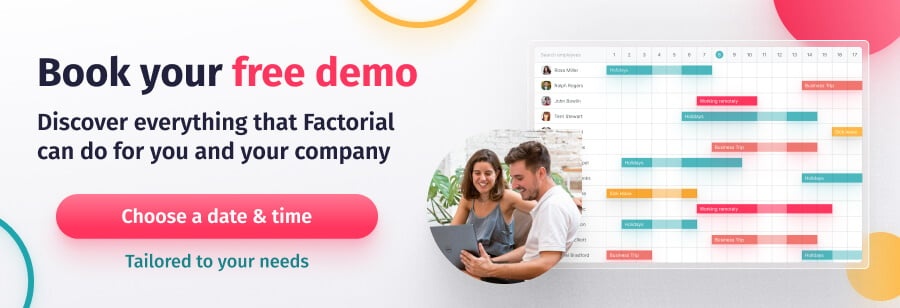A well-crafted job advertisement can help you attract and retain the best talent in your industry, so it is crucial that you get it right. Your ad should explain what the role is, what you expect from the position, and who you are as a company. This will help you engage potential candidates and find the right person for the job.
This comprehensive guide will help you write a job advertisement that attracts the best highly achieving candidates. We will share tips to help you structure and write your job adverts and give you a breakdown of what you should include in each section. We will also look at how the right software solution can help you streamline your system and effectively manage and track your job applicants.
- What Is a Job Advertisement?
- How to Write a Job Advertisement
- Structuring Your Job Advertisement
- Job Advertisement: What to Include in Each Section
- Factorial Applicant Tracking System
What Is a Job Advertisement?
A job advertisement is a post that informs potential candidates of a new opening with the aim of attracting the right talent to the job. It includes a description of roles and responsibilities as well as a list of all desired qualifications, skills and experience. These days most job adverts are posted on online job boards and career sites and offer applicants a direct call to action (although some positions are still advertised through more traditional platforms, such as job centres). Vacancies are often also advertised through newsletters as well as social and local media sources.
A well-structured job advert is an opportunity for you to sell your company and attract the right talent. It should be detailed and informative so that potential candidates are aware of all the requirements and expectations. The right ad gives the reader a sense of who you are as a company, and what you are looking for in an employee. It also highlights why a qualified candidate should apply for a position in your company. This will help you filter out unsuitable applicants and grab the attention of the right candidate, saving you time and money in the long run.
How to Write a Job Advertisement
The first thing to include in your job advert is a clear description of the position being advertised. What will the position entail? Which department or manager will the new hire report to? What roles and responsibilities will the successful applicant undertake? Explain what qualifications, skills and experience you are looking for. Include any relevant information about salary, benefits and location. Make sure you are clear about your expectations and demands. You also need to make sure you include a description about your company. Who are you and what do you do? What are your values? Who would be the right fit for your company?
A job advert is an opportunity to define your ideal hire. What qualifications and experience should applicants have? What aspirations do you value? Which skills are requirements and which are desirable? Create a profile of the candidate you are looking for and make sure your ad stands out. After all, it is the first impression a candidate will get of your business.
Structuring Your Job Advertisement
Getting the structure of your job ad right is essential. It helps potential applicants understand what they are reading and where they need to focus their attention. A simple structure and layout increases the likelihood that the reader will make it to the end of your advert where your call to action is located. Make sure each section is informative, clear and concise and contains only relevant information. Once you define your structure, you might consider creating a template so that all your job ads follow the same layout and structure.
Generally speaking, you should stick to the following structure when you write a job advert:
- Overview of the position: including job title, contract type, department, and who the candidate will be reporting to. What differentiates the role from other similar positions? Make sure you also include details about salary and location.
- Roles and responsibilities: duties and level of responsibility that the role will entail. Employer demands and expectations.
- Overview of your company: who you are and what you do. Your core mission and values. Why candidates would benefit from working for you.
- Desired qualifications, skills and experience: what level of education, skills and experience you expect from a candidate.
- Call to action: how candidates can apply (via email or by completing an online application form, for example).
Job Advertisement: What to Include in Each Section
First and foremost, here are a few tips to consider:
- Include a clear and honest description of the vacancy
- Define realistic expectations and demands
- What character traits would suit the role? For example, if you are hiring a manager then you might value the ability to remain calm under pressure. If you are hiring a customer service rep then being friendly and approachable might be a more desirable trait. Make sure you are clear and avoid any language that could be construed as discriminatory
- Be clear about your company culture, values, mission and vision, and make sure you make a good first impression. Your job advert should aim to be specific and straight forward.
- What sets you apart as an employer? What benefits, work environment and perks can you offer? Will there be opportunities for career development?
- Where will you be advertising the position? What audience will you reach? How can you access more relevant candidates? Make sure you write search-friendly content if you are advertising online.
- Consider the length of your advertisement. Too short and you risk not providing enough valuable information. Too long and you might lose the interest of the reader. Be specific and stick to the point. Use clear and concise language and think about how you structure and format your ad.
Now that we have seen how to structure your job advertisement, let’s break down the various sections. This will help you ensure you include all necessary information in order to attract the right candidate.
Job Title
This is the first thing a potential candidate will see when they come across your job advert so it’s important to get it right. The job title is also the most important keyword when it comes to online searches. Consider the market you are advertising in and stick to the most common title for your vacancy in order to attract the most relevant candidates. Keep it generic and use recognisable keywords. You should aim to repeat the job title at least 3-4 times throughout your advertisement so that it features higher in candidate searches.
Salary and Location
In most countries, it is common to include the salary (or salary bracket) after the job title. This prevents you from wasting time processing candidates with vastly different salary expectations. It is also one of the first things a candidate will look for when they skim a job advertisement. Most companies will also include the location of the job (unless they are advertising a remote position). This helps attract local applicants and increases your chances of appearing in Google’s job search index.
The Introduction
The next step is to provide a brief overview of your company. Explain who you are, what you do, and what markets you work in. Once you have introduced your company, give a brief explanation of the position you are advertising. Use keywords that will help the right candidate identify with the role. What skills should they have? What sort of candidate would be well-suited to the job? Remember, this section is just an overview so there is no need to go into too much detail yet.
The Objectives
This section is to explain what role the successful candidate will hold in the company. What is the purpose of their position? Where do they figure in the company’s hierarchy? (reporting to X, responsible for Y, etc.). How will they relate to other areas of the company? What contribution will they be expected to make to the business?
Responsibilities
This section is where you go into more detail about the roles and responsibilities of the position you are advertising. What expectations does the company have? Using bullet points for this section will make information easier to read and digest. Be open and honest here so that there are no surprises once you hire a candidate. If a job requires 8 hours of data input each day then say so. If you don’t, an unsuspecting new starter expecting action and adventure might run for the hills when they discover what their daily schedule actually entails.
Requirements (Qualifications & Skills)
This section is where you must define any specific requirements for the job in terms of skills and qualifications. Are you looking for a specific educational background? Are qualifications desired or non-negotiable? (If you are hiring a forklift driver, good communication skills are a bonus, but a license to operate heavy machinery is a must). Does the position require previous experience or will training be provided on the job? Will you need to conduct background or DBS checks? Are you looking for any specific soft skills such as enthusiasm or good communications skills? Be clear about exactly what you are looking for here. This will make it much easier to find.
Your Company
In this final section you can expand on any perks or benefits you will offer employees. This is a good point to mention your organisation’s core mission and values. You could also share any relevant details about your culture and working environment. Why should they come and work for you? What benefits and opportunities will you offer them once you hire them? How will you make them feel valued once they are a part of the team?
Factorial Applicant Tracking System
With the tips we have seen in this post you are now ready to write the perfect job advertisement that attracts the best candidate for the job. You know how your ad should be structured and what information you need to include in each section. You might decide to use this information to create a job advert template that gathers all the necessary and relevant data from each candidate during your hiring process.
All that remains now is deciding how you will manage candidate applications to make sure you find the best person for the job. The right Applicant Tracking System (ATS) can help you streamline and manage your processes so that you stay ahead of the game. It can be used to advertise positions, collect candidate data, and filter applicants by experience and skill set. This leads to more efficient and cost-effective recruitment processes and strategies.
With tools such as Factorial’s intuitive applicant tracking software solution, you can track applicants at each stage of the recruitment process in line with your defined policies and procedures. You can create your own customised hiring page, showcase your company, and publish your polished job advertisements through the platform. And once you have found the right candidate for a position, you can effortlessly integrate them with Factorial’s HR recruitment feature.



